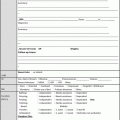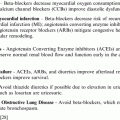© Springer International Publishing Switzerland 2016
Pamela A. Fenstemacher and Peter Winn (eds.)Post-Acute and Long-Term MedicineCurrent Clinical Practice10.1007/978-3-319-16979-8_19Rehabilitation and Maximizing Function
(1)
System Medical Director of Geriatric Medicine and Long Term Care, Main Line Health System, Main Line Health Center, 3855 West Chester Pike, Suite 300, Newtown Square, PA 19073, USA
Keywords
AmputationCare transitionsDeconditioned stateFracture careJoint replacementOccupational therapyOrthoticsMaximizing functionPain managementPayment for rehabilitation therapyPhysical therapyPrevention during rehabilitationPreventing deep vein thromboembolism (DVT)RehabilitationRehabilitation approachesSpeech therapySites of rehabilitation careStrokeTypes of therapy servicesIntroduction
Federal nursing facility regulations require that necessary care and services be provided for residents to “attain or maintain” the highest practicable level of physical, mental, and psychosocial well-being [1, 2]. Rehabilitation (rehab) services and care to promote maximum function are a fundamental component of nursing facility care.
Providing recuperative and rehabilitative services to patients following hospitalization is among the fastest growing segment of health care spending in the USA. A growing number of elders being discharged from hospitals will spend some time convalescing in the long-term care setting especially in a skilled nursing facility with about 1.5 million American elders receiving rehabilitation in nursing facilities each year [3]. This subset of skilled nursing facility residents represents the largest percentage of short-stay nursing facility admissions.
Background
The decision of where to provide rehabilitation therapy following an acute illness is dependent on several factors:
How many therapy modalities are to be utilized.
The number and complexity of concurrent medical problems.
The individual’s physical ability to participate in therapy:
Inpatient rehab facility: requires the patient be able to participate in at least 2–3 h of combined therapies daily.
Skilled nursing facility: the patient is able to tolerate less than 2–3 h of combined therapies daily.
Sites of care:
Inpatient Rehabilitation Facility (IRF).
Long-term Acute Care Facility (LTAC).
Nursing facility and skilled nursing facility.
Assisted living facility.
Program of All-Inclusive Care of the Elderly (PACE).
Home care.
Rehabilitation services can also be provided to long-stay residents of nursing facilities if physical function deteriorates due to an acute and/or chronic illness.
In all settings successful rehabilitation requires that a variety of therapeutic interventions be delivered in a coordinated and timely fashion with the goal to restore and maximize function [2, 4].
Goals for rehabilitation in the nursing facility must be established by a inter-disciplinary team including therapists (OT, PT, ST), nurses, and the attending physician, and aligned with the preferences of the resident.
Goals should be realistic, attainable, and aimed at improving resident function and independence, while respecting the individual’s quality of life and dignity.
Overall prognosis of residents often change over time and can result in the therapy plan being temporarily suspended or altered due to acute change in status and changing or competing goals of care. For example, an acute illness can result in the decision to forego rehabilitation goals of care and instead initiate a more palliative approach or admission to hospice.
Types of Therapy Services
Therapy services have evolved into three traditional rehabilitation disciples: physical therapy, occupational therapy, and speech therapy. Other therapy modalities that are growing in both importance and availability include respiratory therapy, psychotherapy, cognitive therapy, and recreational therapy (which includes music and pet therapy). Although some of these latter modalities (e.g., psychotherapy) may be covered separately under Medicare or other insurance plans, such supportive therapy services may not be separately reimbursed but be routinely provided as part of the nursing facility care per diem. All rehabilitation professionals must coordinate services as part of the comprehensive assessment and plan of care conducted as part of the Federally mandated nursing facility resident assessment protocols (now called care area assessments).
Physical therapy is the discipline that focuses on the restoration of movement and functional ability involving the extremities with particular attention to ambulation and transfer skills.
Occupational therapy as a discipline focuses on promoting the residents ability to participate in activities of daily living such as dressing, grooming, and bathing. While physical therapy focuses on the function of the lower extremities occupational therapy focuses on upper extremity function. Some occupational therapists have acquired expertise in the evaluation of patients with eating and swallowing difficulties.
Speech and language therapy addresses disorders of speech, language, voice, communication, cognition, and swallowing. Speech therapists often provide recommendations for altered consistency diets in residents with dysphagia.
Payment for Rehabilitation Therapy
Under Medicare, the cost of rehabilitation therapy is included in the prospective payment daily rate paid to skilled nursing facilities following hospitalization. (This SNF benefit requires at least a 3-day hospitalization). The daily rate is calculated according to the variety and intensity of rehab and nursing services that are needed and are to be provided. For residents whose nursing facility stay is no longer covered by the Medicare Part A benefit or other private insurance, rehabilitation therapies can then be covered under the Medicare Part B benefit (during an NF or in the community). This coverage is contingent upon the service meeting medical necessity requirements as being reasonable and necessary for the resident’s care. Part B therapy services are subject to cap limits on annual payment.
Multi-morbidities and Frailty
In many cases there is a rather small window of opportunity to initiate rehabilitation therapy services. Elders have an increasing number and complexity of both acute and chronic medical problems—medical multi–morbidities—that can delay rehab. Common conditions include cardiac, pulmonary, gastrointestinal, renal disease, malnutrition, depression, musculoskeletal and neurological problems (including dementia), and finally muscle deconditioning and generalized weakness. Such conditions can interact in dynamic and complex manner to trigger acute functional decline that will then limit the patient’s response to therapy and result in less than optimal rehabilitation outcome.
Prevention During Rehabilitation
Pressure Ulcer Prevention
Residents who are undergoing rehabilitation are often at high risk for pressure ulcer development due to risk factors of immobility, urinary incontinence, and multiple comorbid medical conditions (including diabetes). Aggressive prevention strategies should be implemented. Principles of pressure ulcer prevention that are particularly appropriate include: a frequent turning and positioning schedule (at least every 2 h), managing urinary and fecal incontinence, management of contractures, frequent skin inspection, maintenance of adequate nutrition and hydration, use of offloading or pressure-redistribution devices, and proper transfer and lift techniques [5]. Worsening and delayed healing of pressure ulcers can result in a suboptimal rehabilitation outcome. Prevention and successful management of pressure ulcers will promote the best outcomes (see “Wound Care” chapter for further detail).
Prevention of Venous Thromboembolism (VTE)
Nursing home residents are a frequently overlooked risk group for VTE [6]. Although universal application of VTE prophylaxis to all rehab patients is of unproven benefit, there are circumstances when prophylaxis is essential. VTE prophylaxis has proven benefit for patients who have had surgery for hip fracture or who have had hip or knee arthroplasty. Various agents are approved for use and the duration of treatment for prophylaxis is variable but usually continues for a minimum of 4 weeks. Ongoing research will help determine other high-risk residents who may benefit from VTE prophylaxis. One clinical dichotomy that needs to be balanced as to benefit/risk is the fact that some residents while at high risk for VTE, are also at high risk for bleeding when treated with anticoagulants [7]. Individual patient clinical risk factors and preferences for treatment need to be considered when deciding whom to anticoagulate.
Rehabilitation Approaches for Specific Conditions
Stroke
The goals of rehabilitation for stroke patients include:
Stabilizing and, if possible, optimizing treatment of comorbid medical and psychologic conditions.
Implementing stroke prevention strategies to include the treatment of modifiable risk factors.
Preventing and managing stroke-related sequelae.
Promoting neurological and physical functional recovery.
The rehabilitation phase is critical as up to 20 % of first-ever stroke patients die within the first 30 days with pneumonia, pulmonary embolism, and cardiac complications (e.g., MI, CHF) being the most common causes of death.
Stroke rehabilitation begins immediately upon medical stabilization. The goal should be to prevent recurrent stroke, avoid medical complications, mobilize the patient, and encourage self-care activities. Complications that require active prevention and management strategies include pressure ulcers, spasticity and contractures, bowel and bladder issues (e.g., incontinence, urinary retention, fecal impaction) and prevention of respiratory complications (e.g., aspiration, pneumonia).
Spasticity occurs in over 60 % of patients following a stroke [8]. This manifests as an increase in muscle tone with exaggerated deep tendon reflexes. Although spasticity can sometimes help ambulation, it is often painful and can be debilitating. Management involves daily stretching exercises and avoidance of stimuli that trigger spasticity. In the elderly oral antispasmodic drugs are poorly tolerated due to the common side effects of sedation and confusion. For more severe cares, focal injections of phenol or botulinum toxin may be effective as is serial casting. Muscle contractures occur when there is permanent shortening of a muscle or tendon due to continuous increased muscle tone, which occurs with spasticity of the extremities. Contractures are difficult to reduce and may require surgical intervention. Managing spasticity and promoting stretching and maintaining range of motion are critical to preventing contractures.
Stay updated, free articles. Join our Telegram channel

Full access? Get Clinical Tree





